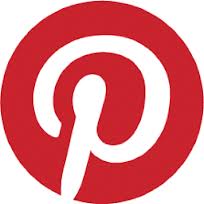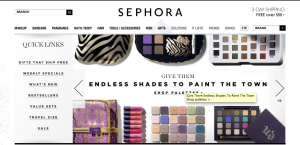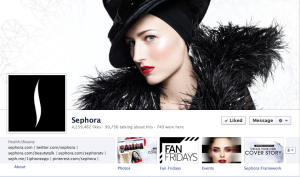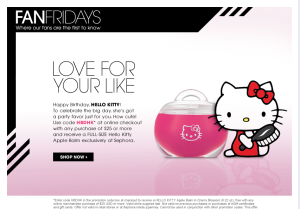Pinterest recently launched a ’30 Days of Pinspiration’ campaign on their site highlighting pinners, brands and non-profits as we build up to the holiday. The campaign is featured on the website as a separate link or tab up at the top and once clicked, the viewer is presented with an advent calendar style page. Each day will feature a different pinner, brand or non-profit and it will not be revealed until that day.
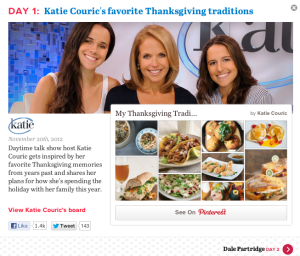 So far, Pinterest has used Katie Couric, who launched the campaign as the first featured pinner, Anthropologie, Pottery Barn and Parents Magazine, among others.
So far, Pinterest has used Katie Couric, who launched the campaign as the first featured pinner, Anthropologie, Pottery Barn and Parents Magazine, among others. Each pinner, brand or nonprofit is supposed to feature content that talks about what inspires them this holiday season and that correlates to their board on Pinterest. For example, Katie Couric’s Pinspiration comes from her holiday Traditional Family Recipes. Since it’s start on November 2, the campaign will continue until the New Year) Katie Couric’s post has been the most popular with 1.4K likes on Facebook and 143 Tweets referring to it. While Pinterest has come up with great content for this campaign, it doesn’t seem as if that many people are engaging with it on other social channels.
Each pinner, brand or nonprofit is supposed to feature content that talks about what inspires them this holiday season and that correlates to their board on Pinterest. For example, Katie Couric’s Pinspiration comes from her holiday Traditional Family Recipes. Since it’s start on November 2, the campaign will continue until the New Year) Katie Couric’s post has been the most popular with 1.4K likes on Facebook and 143 Tweets referring to it. While Pinterest has come up with great content for this campaign, it doesn’t seem as if that many people are engaging with it on other social channels.
Since Pinterst is itself a social media channel, it is hard to examine how it exists through other sites. It has a page through App Center on 
 Facebook which basically describes what it is and allows you to go to the website. Pinterest does have a Twitter handle (@Pinterest) and it seems like they only tweet about once a day and it seems like most of the interaction comes from fans retweeting or favoriting their tweets, not too many of their followers are generating conversation from their tweet. The ’30 Days of Pinterest’ campaign has used the hashtag #pinspiration to attempt to create some engagement on Twitter. According to Twazzup.com, #pinspiration has been generating approximately 7 tweets per hour, which doesn’t seem very high of a number for how many people are on Pinterest altogether.
Facebook which basically describes what it is and allows you to go to the website. Pinterest does have a Twitter handle (@Pinterest) and it seems like they only tweet about once a day and it seems like most of the interaction comes from fans retweeting or favoriting their tweets, not too many of their followers are generating conversation from their tweet. The ’30 Days of Pinterest’ campaign has used the hashtag #pinspiration to attempt to create some engagement on Twitter. According to Twazzup.com, #pinspiration has been generating approximately 7 tweets per hour, which doesn’t seem very high of a number for how many people are on Pinterest altogether.
Pinterest is using their ’30 Days of Pinspiration’ to show how many different types of pinners, whether it is an individual, a brand or a non-profit organization. To me this seems like a smart move since now that Pinterest has become a more established social platform, brands and organization and celebrities are trying to tap into this resource and see what kind of benefits and interactions they can get out of it. Second Harvest Heartland used their Pinspiration opportunitiy to discuss how around the holidays, we should be doing even more for those who do not have food. Using different sorts of people or organizations, like using Pottery Barn vs. Honeslty WTF to using Dale Partridge (founder of sevenly.org) is a great way to not only inspire individuals and get more interaction going, but to also showcase how some brands and nonprofits are using this new platform. Maybe after this campaign, more brands and nonprofits will join the Pinterest club.
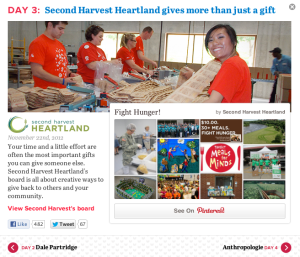
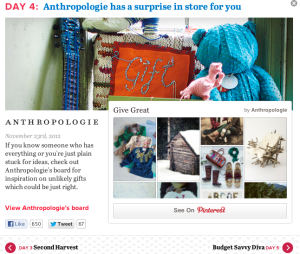
Overall I think this is a decent campaign. Pinterest obviously took advantage of the visual quality and aspect of their brand, which we know, is what gets the most interaction and engagement going. I was surprised that not as many people were interesting with the posts, but I think this might be hard to track since I wasn’t able to find how many people repined things off of the boards featuring in the calendar. I think the idea of this campaign is something that other brands should adapt, and I’m sure many brands have been doing campaigns like this. Having a campaign that features a calendar gives people something to look forward to or anticipate. Especially in the height of the Christmas season people are counting down the days until the holiday and they are looking for inspiration for holiday gifts.
